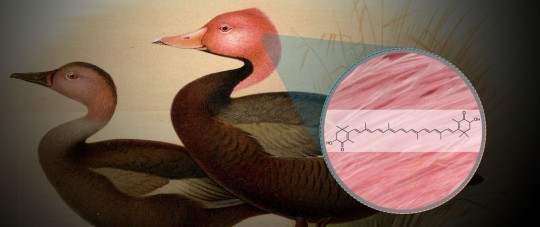
Feather pigments in the Pink-headed duck were recently analysed with Raman spectroscopy. Image adapted from: Henrik Grönvold (1858–1940). Journal of the Bombay Natural History Society Volume 18. The Pink-headed Duck Rhodonessa caryophyllacea = Rhodonessa caryophyllacea (Pink-headed Duck)
Birds are living dinosaurs. Modern birds and extinct beast-footed dinosaurs (i.e. theropods) have many traits in common because they inherited these traits from the same ancestor, e.g. s-shaped necks, fused clavicles (…wishbones) and feathers. Many living birds have brightly coloured feathers, which leads us to wonder if ancient dinosaurs also had colourful plumage. One way we can answer this is by studying living dinosaurs (…birds). If two closely related birds have red feather pigments, like Northern and Desert cardinals, then we would suppose that they inherited this pigment trait from a recent shared ancestor. The more-distantly related two birds are that share the same trait, the older the ancestor must be that they inherited the trait from. If we can find two very distantly related birds with brightly coloured feathers then we might think they inherited that trait from an ancestor that was alive during the Age of Dinosaurs.
Cardinals and ducks are very distant relatives.
Dr Helen James from the Smithsonian Institution National Museum of Natural History and I have been studying bird species that have carotenoid-pigmented plumage. Carotenoids are responsible for most of the red, orange, yellow and pink colours we see in feathers. In our search we discovered that the Pink-headed Duck (Rhodonessa caryophyllacea) has carotenoid-pigmented plumage. These pigments are rare among ducks and a few years ago we discovered the only other known occurrence: the pink ‘ears’ of the Pink-eared Duck (Malacorhynchus membranaceous). In fact, these occurrences are so rare that when we model the evolution of carotenoids in duck feathers our results tell us that pink feathers in each species evolved independently and were not inherited from ancient dinosaurs. This is still a bit puzzling and it suggests that we need to dig deeper. Maybe into the genetics of feather pigmentation. If the same “carotenoid feather pigment” genes are found in cardinals and ducks, it may mean that ancient dinosaurs had brightly coloured feathers as well.
Leave a comment